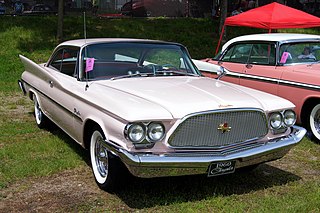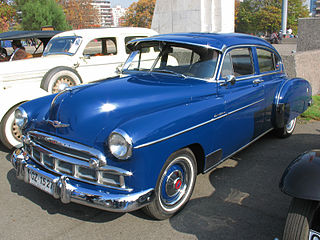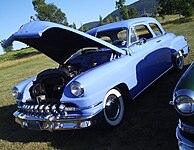
The Oldsmobile 98 is the full-size flagship model of Oldsmobile that was produced from 1940 until 1942, and then from 1946 to 1996. The name – reflecting a "Series 90" fitted with an 8-cylinder engine – first appeared in 1941 and was used again after American consumer automobile production resumed post-World War II. It was, as it would remain, the division's top-of-the-line model, with lesser Oldsmobiles having lower numbers such as the A-body 66 and 68, and the B-body 76 and 78. The Series 60 was retired in 1949, the same year the Oldsmobile 78 was replaced by the 88. The Oldsmobile 76 was retired after 1950. This left the two remaining number-names to carry on into the 1990s as the bread and butter of the full-size Oldsmobile lineup until the Eighty Eight-based Regency replaced the 98 in 1997.

The Dodge Coronet is an automobile that was marketed by Dodge in seven generations, and shared nameplates with the same bodyshell with varying levels of equipment installed. Introduced as a full-size car in 1949, it was the division's highest trim line and moved to the lowest level starting in 1955 through 1959. The name was reintroduced on intermediate-sized models from the 1965 until 1976 model years. Muscle car versions were available starting in 1965 with the 383 and 426 wedge cu in Chrysler RB engine, followed in 1966 by the powerful 426 cu in Chrysler Hemi. Other performance models included the "Superbee", and featured, the 383 cu in Magnum, among other engine options. The nameplate "coronet" is a type of crown worn by royalty.

The Series 60 "Special" is a full-size car made by Oldsmobile from the 1939 through the 1948 model years. It was their entry-level model using the GM "A" body platform, giving Oldsmobile an entry level product with more standard features that would be optional on Chevrolet and Pontiac vehicles using the same platform. Initially, the engine size used was the company's flat head 6 cylinder, while senior models would use the flat head 8 cylinder. For marketing purposes, the Oldsmobile Series 60, or the Oldsmobile 66, took advantage of the national highway U.S. Route 66 established in 1926.It was with this generation that all GM vehicles experienced increased width dimensions to accommodate three passengers on the front bench seat and an additional three passengers on rear bench seat installed vehicles. This was accomplished with the deletion of running board thereby adding additional room inside the passenger compartment and upgrading the floor mounted gearshift to a steering column installed transmission gear selector for the Hydramatic automatic transmission.

The Oldsmobile Series 70 is a full-size midrange automobile produced by Oldsmobile between the 1939 and 1950 model years. Oldsmobiles of this time period were in an unusual "middle" position in GM's hierarchy of automobile brands. Chevrolet and Pontiac were the budget priced models, while Buick and Cadillac were the luxury brands. GM would share their "A" body platforms between Chevrolet, Pontiac, and "B" body on Oldsmobile and Buick, while leaving Cadillac on the senior "C" platform. Oldsmobiles were then branded as "luxury level" Chevrolet's and Pontiac's, while Oldsmobiles using the "B" platform were "budget priced" Buicks and Cadillacs.

The Studebaker Champion is an automobile which was produced by the Studebaker Corporation of South Bend, Indiana, from the beginning of the 1939 model year until 1958. It was a full-size car in its first three generations and a mid-size car in its fourth and fifth generation models, serving as the junior model to the Commander.

The Chrysler Saratoga is an automobile built by Chrysler. The nameplate was used from 1939 to 1952 and from 1957 to 1960 in the U.S. market, in Canada through 1965, and in Europe from 1989 to 1995. In the beginning, it was introduced as a sport luxury model, using the Straight Eight engine from the Chrysler New Yorker which was more formal, and the Imperial which had graduated to special order limousine.

The Chrysler Windsor is a full-size car which was built by Chrysler from 1939 through to the 1960s. The final Chrysler Windsor sold in the United States was produced in 1961, but production in Canada continued until 1966. The Canadian 1961 to 1966 Windsor model was for all intents and purposes the equivalent of the Chrysler Newport in the United States.

The Dodge Kingsway is an automobile built by Dodge for export markets. The Kingsway name was adopted for the 1940 models. Before that, the export models based on Plymouth models had no unique model names.

The Ford Custom is an automobile which was produced by Ford in the United States, Canada and Australia in certain years from 1949 to 1981.

The Pontiac Chieftain is an automobile which was produced by Pontiac from 1949 to 1958. The 1949 Chieftain and Streamliner models were the first all new car designs to come from Pontiac in the post World War II years. Previous cars had been 1942 models with minor revisions.

The DeSoto Six was first introduced in 1929 and was badge engineered from the 1929 Chrysler Six Series 62 with the same 109.75 in (2,788 mm) wheelbase, while it offered a smaller 174.9 cu in (2.9 L) Chrysler I6 with an overall length of 169 in (4,293 mm). It was offered in four two-door sedan configurations and three four-door sedan body styles. It used the Series K designation for two years then was updated to the Series CK in mid-1930.

The Mercury Eight is an automobile that was marketed by the Mercury division of Ford between 1939 and 1951. The debut model line of the Mercury division, Ford slotted the full-size Mercury Eight between the Ford Deluxe model lines and the Lincoln. In total, Ford assembled three generations of the Eight.

The Ford car was thoroughly updated in 1941, in preparation for a time of unpredictability surrounding World War II. The 1941 design would continue in an aborted 1942 model year and would be restarted in 1946 and produced until 1948 when the more modern 1949 Fords were ready. During the initial year of this car, it evolved considerably. The front fenders came in three pieces, the theory being that small damages could be replaced easily. During the year, it evolved into two pieces with the lower front and back sections being joined. The hood risers changed, the early ones being the same as 1940 Fords, changing during the year to the better later version. The 1941 Convertible had no rear side windows, the only side windows being in the doors; in 1942, quarter windows were added so the rear occupants could see out.

The 1949 Ford is a line of cars produced by Ford from the 1949 to 1951 model years. The successor to the prewar 1941 Ford, the model line was the first full-size Ford designed after World War II, becoming the first Ford car line released after the deaths of Edsel Ford and Henry Ford. From 1946 to 1948, each of the American Big Three concentrated on the restoration of car production, offering updated versions of their 1941-1942 model lines. Released in June 1948, the 1949 Ford was the first major "postwar" American car line, beating Chevrolet to market by six months and Plymouth by nine.

The Plymouth De Luxe and Special De Luxe were full-sized automobiles which were produced by American manufacturer Plymouth during the 1933-42 and 1946-50 model years.

The Chevrolet Special Deluxe Series AH Fleetline was an automobile produced by US automaker Chevrolet from 1941 to 1952. From 1946 to 1948 it was a sub-series of the Chevrolet Fleetmaster rather than a series of the Special Deluxe and, from 1949 to 1951, it was a sub-series of both the Chevrolet Special and the Chevrolet Deluxe. In its final year it was offered only as a sub-series of the latter.

The Chevrolet Deluxe is a trim line of Chevrolet automobiles that was marketed from 1941 to 1952, and was the volume sales leader for the market during the 1940s. The line included at first a 4-door sedan, but grew to include a fastback 2-door "aerosedan" and other body styles. The 1941 Chevrolet was the first generation that didn't share a common appearance with Chevrolet trucks, while the Chevrolet AK Series truck did share common internal components.

The Pontiac Torpedo was a full-sized car produced by Pontiac from the 1940 through the 1948 model year. When released, it was the biggest Pontiac, used an 8-cylinder engine, and it had more standard features than other Pontiacs. Although the Torpedo name was exclusive to the highest line of Pontiacs in 1940, in 1941 the name was applied to all Pontiacs in three separate lines. The Custom Torpedoes were now top-of-the-line name, while the DeLuxe Torpedo became the base line, and the Streamline Torpedo became the middle line of Pontiacs. All Torpedo models could be had with either a 6-cylinder or 8-cylinder engine beginning in 1941. From 1942 to 1948 the Torpedo name designated only the base line of Pontiacs. The Torpedo was replaced by the Pontiac Chieftain in 1949. It was with this generation that all GM vehicles experienced increased width dimensions to accommodate three passengers on the front bench seat and an additional three passengers on rear bench seat installed vehicles. This was accomplished with the deletion of running board thereby adding additional room inside the passenger compartment.

The Lincoln EL-Series is a full-size luxury car that was marketed and sold by Lincoln from 1949 to 1951. Replacing the H-Series Lincoln, the postwar model line was the first complete redesign of the Lincoln sedan line since 1936. In line with its predecessor, the EL-Series Lincoln carried only the Lincoln nameplate, using no divisional branding; the Lincoln was slotted below the Lincoln Cosmopolitan within the Lincoln model range.

The Dodge Custom is a full-size car which was produced by Dodge in the United States from 1946 to early 1949, and was also called the DeLuxe in a more basic trim package. Dodge was very fluid with model nameplates and during the 1930s updated them yearly based on marketing objectives, while the actual vehicle was largely unchanged for what became known as the "Senior Dodge's" that were available with shorter "Junior Dodges" that were essentially badge engineered Plymouth models during this time period.























